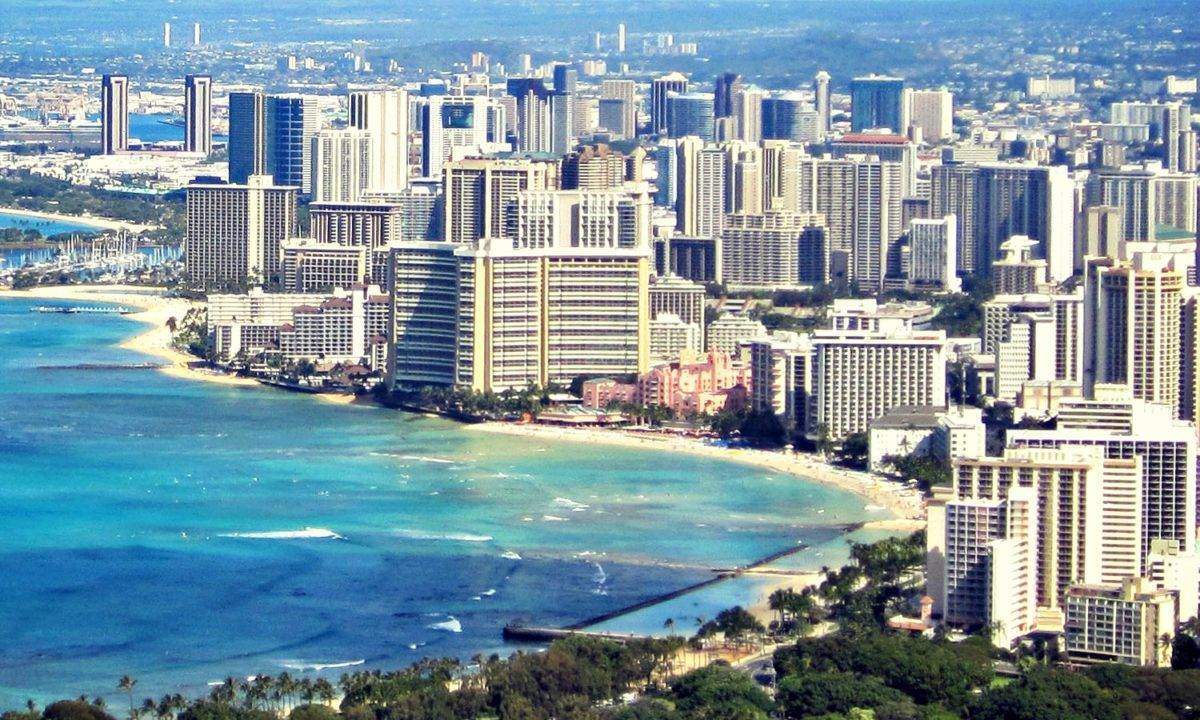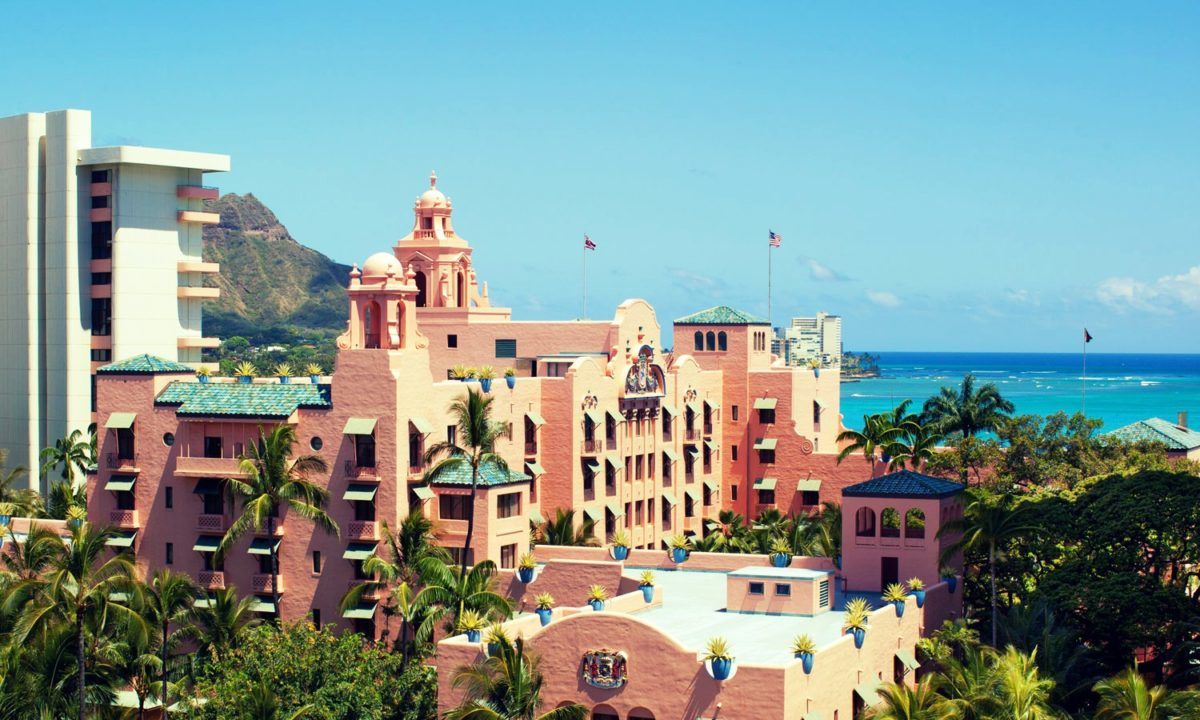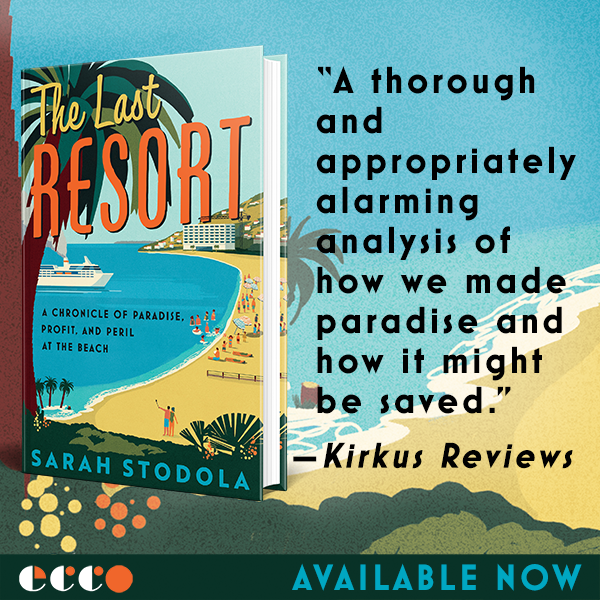The drive into Waikiki from the Honolulu Airport takes us first along the city’s notoriously clogged freeways, victims initially of bad design and later an undercalculated influx of people and cars. Stopping, then going, crawling then picking up speed, the torture-device boredom of automobile travel finally sedates us and we sink further, into the cacophony of Waikiki itself, along the streets of which there is no sign of the ocean, only a concrete and brick milieu that could easily stand in for the business district of a mid-sized Midwestern city, Hermes and Chanel stores and throttling crowds notwithstanding. I have seen nothing so far to indicate the Hawaii that people gush about. So far, this isn’t paradise, it’s just more America.
The van turns into an entrance, to what is not exactly clear. Buildings still loom on all sides with a very modern confidence, as if we are on just another of the city’s hectic streets. We ride past a 39-story, 1,600-room Sheraton. Just beyond it, finally, the grounds of the Royal Hawaiian Hotel stand almost as if in hiding, preserved as they have been for eight decades, tucked in at the end of the way through a low-slung gate, the passage to the other side of which feels like the switch from black and white to color; an amusement park ride into what Waikiki might have been, or less likely, what it once was.
What it once was: among other things, the place where Joan Didion wrote one of her best sentences. “We are here in this island in the middle of the Pacific in lieu of filing for divorce.” It’s worth pointing out that this sentence all on its own has sent many practical people into the throes of a writing career. The essay that contains it, “In the Islands,” covers Hawaii more broadly, its history and its problems, but it’s the passages in which Didion considers her more personal memories of Hawaii that make the essay transcendent. It’s these passages that in the early years of the millennium hooked a fumbling grad student on Joan Didion’s coolly devastating prose and then, by natural extension, on the places from which it sprang.
And so it’s these passages that lead my boyfriend and me, years later and on the final night of a trip to Hawaii otherwise spent avoiding Waikiki, to book a room at the Royal Hawaiian. We get a deal because of a family connection at Starwood, the corporation which now owns the hotel. I tell the connection I have my heart set on a room in the old original building. Won’t be a problem, she says. Everyone wants to be in the new tower.
At check-in, while waiting an unreasonably long time considering the room prices, we take in the open-air lobby, which some executive at some point during some renovation acknowledged would not be improved by air conditioning. The outdoors are right there, streaming in through a line of enormous arched doorways that make me think of 19th century Europeans in Africa, gin and tonics in buildings made of materials that are cool to the touch. Our turn comes up and, in what seems to be the current fashion for high-end resorts, we approach not a counter but an extravagant desk, where we sit down across from an attendant. For no reason that we are aware of, we are upgraded to a suite. We will learn only later that it has no ocean views.
From her own room on some eerie afternoon in some other decade, Didion was “watching the long translucent curtains billow in the trade wind and trying to put [her] life back together.” Today, those windows open only a couple inches, and the Royal Hawaiian is no longer an appropriate backdrop for that kind of crisis. After a brief attempt at recreating the billowing, I opt to leave the windows shut, submitting to a climate control that no executive would have vetoed and that negates the splendid things Hawaiian air does to a person’s hair and skin. This is no crisis, of course. There is no crisis of any kind, and that I feel the absence of one speaks to a tendency to maybe romanticize the wrong things.
I make a writing desk of the table in the suite’s living room. We turn the ceiling fan on to a speed that could have coined the word desultory. I pocket a notepad from the nightstand, an act that I choose to believe inches me closer to the hotel’s history, which began when it opened in 1927. Known as the Pink Palace for obvious reasons, with its pink stucco façade popping against the blues of the sky and ocean, the Royal Hawaiian was the second resort on Waikiki—the Moana came first, in 1901, from the same owner. Guests arrived by ship, and they stayed for months. Long before any of this, in the 19th century, Waikiki was a playground for Hawaiian royalty. When the Royal Hawaiian opened, its first guest was the woman who would have been queen of Hawaii, had the islands not come under American rule.



We go downstairs and sit in rocking chairs on a swollen veranda, its black and white stone floors solid beneath our feet, the pink stucco columns holding up a roof that protects us just this moment from a brief afternoon rain. In front of us sprawls a sort of imperial lawn, green grass at the center giving way abruptly at the edges to tropical foliage—it would be easy to imagine something Forster-esque breaking out here, were it not for the high rise hotels crowding in at its far end, a reminder that now is now, and that the terms of glamorous travel were at some point rewritten. Those high rises crowd in on the Royal Hawaiian not just from across the one lawn, but from everywhere, while the Royal Hawaiian holds them gamely at bay. That the grand dame of Waikiki resorts has survived the ambush gives it a patina both impressive and pitiful. Also, different entirely from the “distant and mildly exotic” place where Didion lounged amongst the right kind of people.
The Royal Hawaiian and its environs come into panoramic focus later in the evening, as the boat we are on leaves behind the beaches of Waikiki, spawning one of those moments of visual trickery that we have all experienced at one time or other: a very tall person stands next to a very tall person, making the former appear diminutive. Or, the iPad Mini comes out, giving the regular iPad the appearance of a monstrosity. The once grand Royal Hawaiian is now chastened by the many-windowed behemoths. A diminutive pink dot among the very tall. Among the monstrosities.
That boat from which we observe the shoreline may as well be given up for what it is: a booze cruise. A group of 10 or so kids from the outskirts of Philly who are crashing not at a resort but at a friend’s apartment in Honolulu, a honeymooning couple, and a solo Asian woman accompany us, all having paid $30 for an hour and change of open bar on the open water. Two of the Philadelphians ride out their seasickness at the bow while the captain hits on the Asian woman. Out of embarrassment or wont of companionship, she accepts his crusty-surfer advances. The sun sets and, looking back to the shore, we see the grey slabs of buildings become twinkling hemispheres. The Royal Hawaiian melts into the larger sparkling picture. It looks like a real city, my boyfriend says.
Back on shore: Just another day in paradise, our waitress says when we ask how she’s doing. Just another day in paradise, says the surfer sitting next to us on the beach. Just another day in paradise. It’s what people in Hawaii say to you instead of saying fine. It’s a phrase always spoken with a hint of unforeseen sarcasm, confessing in the subtext certain connections between leisure and perfection and despair.
We sit on the hotel’s terrace, eating our lunch and staring out at the ocean through a procession of pink umbrellas. What is most remarkable, we observe, is the complete absence of elements. Neither too hot nor too cold nor whipped by a breeze nor suffocated by a stillness, the water just as turquoise as is possible without becoming a cartoon. Beachgoers wade hundreds of yards out with their surfboards or paddleboards or just their own bodies and a loved one or two. They dot the bay like pleasure-seekers in a Seurat painting, and when they come in, they pay $14 for a cocktail with the savings from their $60,000 salary back home, at one with the contemporary American insistence that spending beyond one’s means can fool not only everyone else but also oneself.
Didion would be nonplussed, if she still vacationed here, because it wasn’t always so. “The Royal Hawaiian is not merely a hotel but a social idea, one of the few extant clues to a certain kind of American life,” she wrote in 1969, referring to the passive privilege of previous generations’ elite, a privilege that could safely rest on its laurels. The social idea at the Royal Hawaiian today is different, full of brazen striving and no longer distinctly American; just ask the scores of guests who have flown in not from Los Angeles or Portland or even, like me, New York, but from Tokyo or Taipei, and who insist on a room in the new tower, the Royal Hawaiian’s very own monstrosity, built in an ominous year for architectural projects, 1969, in order to increase the total capacity of the resort.
“To understand what the Royal is now you must first understand what it was,” Didion wrote. But by now, that linear link has been broken. To understand what the Royal Hawaiian is now you must first understand that what it once was has been obliterated. Perhaps to the Japanese tourist, the Royal Hawaiian still offers clues to a certain American life, but only in the same way that the Lower East Side today offers clues to the immigrant experience.
We imagine what it once was, nonetheless. The privilege, we imagine, was more tasteful. It kept its designer labels tucked in, and it paid its bills up front. Unlike today’s privilege, it mixed well with modesty. This is how we imagine it, as we watch the woman in the resort collection dress and Louis Vuitton tote stroll through the lobby, texting as she walks.
Of this new version of privilege, it’s easy to see that its center cannot hold – to borrow a phrase from Didion, who borrowed it from Yeats. Beneath the Louis Vuitton tote is the ill-advised credit card debt that made it possible. Behind the resort collection dress, two hours waiting in line at the sample sale. But then, we project onto the privilege of the past a tastefulness which also does not hold up to scrutiny. The Royal Hawaiian and the Moana are, after all, guilty of the original sin against the standards of good taste in this story. They made the wider world take note of Waikiki Beach in the first place – “made all things ‘Hawaiian’ … a decade’s craze at country-club dances across the United States,” Didion notes. Of the old privilege, it’s easy to see that its center was the exemplar mirage.
It’s hard to say what I thought I was looking for in the Royal Hawaiian. The closest available approximation of a place known through the gauzy memories of someone whose perspective I admire, I suppose. The Royal Hawaiian, a place I felt close to for years without ever having set foot on its grounds, taking ownership of someone else’s experiences only because I loved the way she’d worded them. Places. How they change. How they roll around in our memories. How we assign them meaning. How we jump from the page of a book and onto an airplane expecting a seamless transition and coherent narrative.
Midway through our second day in Waikiki, we can no longer head off a panicky ennui. There is no relief between us and 10pm, when we go to the airport to fly home to New York. The pressure to spend money cannibalizes leisure and sunshine. At every turn, there’s no escaping the smothering crowds unless one is willing to pay for the seclusion, in an overpriced bistro or overpriced pub or overpriced boat ride, none of which are convincing in their intimation of experience. We feel the crackle of insanity. Back in the hot tub at the Royal Hawaiian, a waiter comes by with a tray of pineapple slices, toothpicks sticking up. This small gesture provides such satisfaction, such momentary escape, that we hate it almost immediately, for reminding us in contrast about everything else.
And yet, since our return, I’ve squandered more than one afternoon chasing down old photos of the Royal Hawaiian online. A postcard bearing an image of the hotel in 1928 now hangs framed in our bathroom. My own memories still mingle with the ones I have only read about. Looking at the postcard, I marvel at the bird’s eye views of the Waikiki shoreline, empty but for the two great resorts. I marvel that once there were single-family houses on Waikiki Beach. I marvel at the untouched land behind the shore. I marvel at how obvious it is that Waikiki was once truly far-flung. And then, how obvious it is that decades later, by the time I made my visit, the Royal Hawaiian had become the backdrop for a very different kind of crisis.
-by Sarah Stodola
Feature image credit The Royal Hawaiian.
Flung uses affiliate links in this article. Read our Affiliate Link Policy here.







